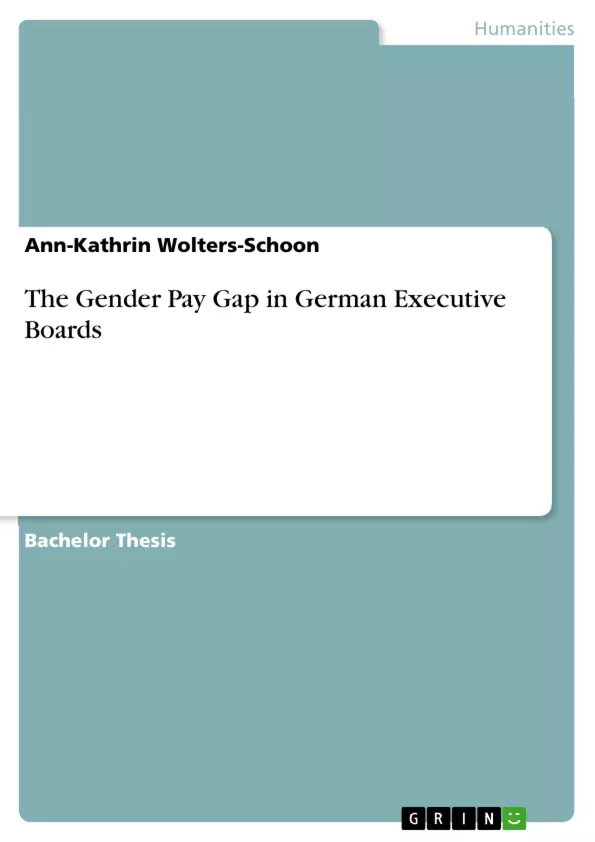This study aims to determine the extent to which existing general theories and explanations for the gap are applicable to the specific and homogenous group of top executives and chairpersons. Key explanations for the gender pay gap are theorized to be company size, the executive’s position within the board and industry line.
Additionally, existing labor market theories suggest that the size of the discriminated group has an impact on the amount of discrimination, so that the number of females has an impact on the gender pay gap.
A linear regression was conducted to validate the explanations. Moreover, the effect of the minority group’s size was analyzed within another set of regressions, using as moderators the proportion of female board members and the proportion of male workers within the industry. The hypothesis states that an increase in the size of the minority group causes a decrease in the effect of gender on earnings.
The dataset was provided by Kienbaum Consultants International GmbH and included information on the base, variable and total compensation of 1,080 board members (N = 1,080) among DAX- and MDAX-listed companies in the years 2014-16.
The results show significant effects of gender on earnings, even after taking into account the board members’ position, the industry line and the size of the company.
Both company size and position show a positive significant coefficient for the earnings regression, while industry does not show a significant effect.
For the moderator analyses, neither the proportion of females on the board nor the proportion of females within the industry had a significant widening or shrinking effect on the gender pay gap. This leads to the assumption that neither one influence the gender pay gap.
However, I found major inequalities of the gender pay gap in base and variable compensations. In a post-hoc analysis I tested significant differences in mean target compensation and mean payout level. The results show no significant differences in target compensation, yet in payout level, which suggests that further research on the topic of performance management is needed.
Inhaltsverzeichnis (Table of Contents)
- Abstract
- Introduction
- Theoretical Framework
- The Gender Pay Gap and State of the Art
- Explanatory Factors for the Gender Pay Gap
- Moderating Effects of the Minority Group’s Size
- Methodology
- Procedure
- Sample
- Measures
- Method of Analysis
- Results
- Descriptive Statistics
- Discussion of Hypotheses
- The gender pay gap
- Analysis of explanatory factors
- Moderating effect of male proportion within the sector
- Moderating effect of gender diversion on the board
- Post-hoc analysis
- Discussion and Conclusion
- Interpretation of results
- Discussion and recommendations for future research
- Strengths and Limitations
- Conclusion
Zielsetzung und Themenschwerpunkte (Objectives and Key Themes)
This study aims to determine the extent to which existing theories explaining the gender pay gap apply to top executives. It investigates whether company size, executive position, and industry influence the gap, and whether the size of the female minority group moderates this effect.
- The gender pay gap in German executive boards.
- The influence of company size, executive position, and industry on the gender pay gap.
- The moderating effect of the proportion of female board members on the gender pay gap.
- The moderating effect of the proportion of female workers within an industry on the gender pay gap.
- Differences in base versus variable compensation and their relation to the gender pay gap.
Zusammenfassung der Kapitel (Chapter Summaries)
Chapter 1: Introduction introduces the gender pay gap debate in Germany and highlights the study's focus on top-management teams for increased homogeneity.
Chapter 2: Theoretical Framework explores existing theories on the gender pay gap, including the human capital model and occupational segregation (horizontal and vertical). It also introduces the concept of the minority group's size as a potential moderator.
Chapter 3: Methodology details the data sources (Kienbaum), sample (DAX and MDAX companies, 2014-2016), measures (compensation types, gender, position, company size, industry proportions), and analysis methods (linear regression).
Chapter 4: Results presents descriptive statistics on the sample and the gender pay gap. It then presents the findings from the regression analyses, testing the main hypotheses regarding the influence of explanatory factors and the moderating effects of minority group size.
Schlüsselwörter (Keywords)
Gender pay gap, executive compensation, Germany, DAX, MDAX, occupational segregation, human capital, minority group size, board diversity, linear regression, performance-based pay.
- Quote paper
- Ann-Kathrin Wolters-Schoon (Author), 2018, The Gender Pay Gap in German Executive Boards, Munich, GRIN Verlag, https://www.grin.com/document/1514693



